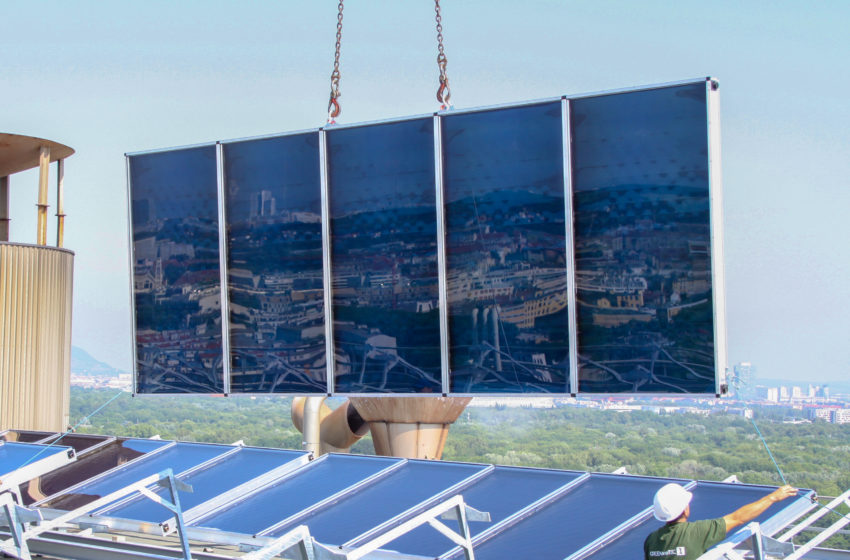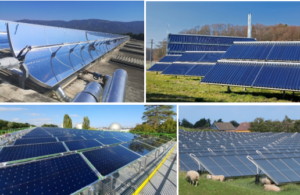Large prefab SDH collectors: design and yields
August 18, 2021
Photo: Greenonetec
Savosolar has a similar product range, offering both single- and double-glazed flat plate collectors. To reduce heat loss, the manufacturer has decided to place all collector connectors inside the insulated collector housing. In addition, it has designed a mounting system that allows two collectors to rest on the same support, reducing the time and expenses needed for their installation, Savosolar said.
Every collector manufactured by the companies discussed in this news article also comes with a Solar Keymark certificate. It includes yearly collector yields for three average collector temperatures for several locations in Europe which are calculated by the testing institutes based on measurement data. The results of these calculations can then serve as a basis for comparing collector performance. The following chart depicts, based on a mean temperature of 50 °C and 75 °C, the estimated specific annual yield the relevant collector could produce per square metre at the Würzburg site in Germany. Of note is that at a temperature of 75 °C, the specific yield of any of the 14 large prefab collectors selected in this scenario is, on average, 29 % lower than if the same unit were operated at 50 °C. If only single-glazed flat plate collector are considered, the average reduction in output is even higher, increasing to as much as 37 %. Anti-reflective coating on one or two sides of the glass cover also impacts the yield of this type of collector significantly, but this feature is not mentioned in the table.

Yield comparison of selected large prefab collectors. Source: Solar Keymark certificates
| Company | Country | Collector series | Range of gross area per collector panel [m2] | Collector type | Absorber type | Website |
| Akotec | Germany | Mega | 12.99 | heat-pipe vacuum tube | full-copper strips | https://www.akotec.eu/ |
| DOMA | Austria | Flex Alu | 3.5 to 14.6 | single-glazed flat plate | laser welded Alu-copper fins | https://www.domasolar.com/ |
| Gasokol | Austria | gevoSol | 2.25 to 12 | single-glazed flat plate | full copper strips | https://www.gasokol.at/ |
| Gasokol | Austria | powerSol | 5.46 to 13.59 | double-glazed flat plate | full copper strips | https://www.gasokol.at/ |
| Greenonetec | Austria | GK2002 | 5 to 10 | single-glazed flat plate | https://www.greenonetec.com/ | |
| Greenonetec | Austria | GK3003 | 8 to 13 | double-glazed flat plate | full-plate aluminium-copper | https://www.greenonetec.com/ |
| Ritter XL | Germany | XL 19/49 | 4.94 | u-pipe vacuum tube | aluminium absorber | https://www.ritter-xl-solar.de/ |
| Savosolar | Finland | 15 SG | 15.96 | single-glazed flat plate | Aluminium Multi Port Extrusion Profile | https://savosolar.com/ |
| Savosolar | Finland | 15 DG | 15.96 | double-glazed flat plate | Aluminium Multi Port Extrusion Profile | https://savosolar.com/ |
| Solvis | Germany | Fera | 5.61 to 8.4 | single-glazed flat plate | full-plate aluminium-copper | https://www.solvis.de/ |
| SST Solar | Austria | ECO | 6 to 24 | single-glazed flat plate | full copper absorber | https://www.sst-solar.com/ |
| Viessmann | Germany | Vitosol 100-F XL | 7.91 to 13.17 | single-glazed flat plate | full-plate aluminium-copper | https://www.viessmann.de/ |
| Viessmann | Germany | Vitosol 200-T SPX-5 | 5.05 to 10.3 | heat-pipe vacuum tube | n/a | https://www.viessmann.de/ |
Source: manufacturers’ information


